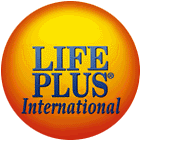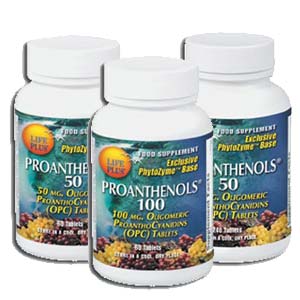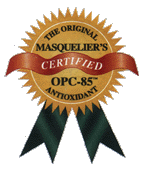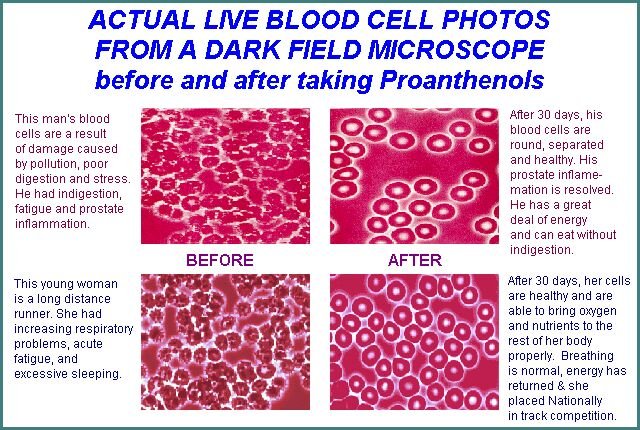
PROANTHENOLS BIO-COMPLEX
Fight free radicals
and ageing


PROANTHENOLS BIO-COMPLEX
Fight free radicals
and ageing

POWERFUL ANTIOXIDANTS
Free radicals are
incredibly destructive. They damage our cells, which can mean premature
aging, reduced immune function, inflammation and ultimately degenerative
disease. Our primary defense is antioxidant nutrients, of which the most
well known are Vitamins C and E. The biological activity of antioxidants
is enormously important to our health. OPC's are very powerful antioxidant
free radical scavengers. They are as much as 50 times more powerful
than Vitamin E and 20 times more powerful than Vitamin C. OPC's
are major protectors of collagen, the basic foundation our blood vessels
and all connective tissues such as skin, ligaments around joints and tendons.
HISTORY
In 1928, Albert Szent-Gyorgyi isolated Vitamin C. It helped prevent scurvy, but results were not consistent. He later isolated bioflavonoids, which he called Vitamin P. He blended the two together and called the mixture "citrin," which was more reliable but still inconsistent.
Then in 1947, Professor Dr. Jack Masquelier, working at the University of Bordeaux, isolated the first proanthocyanidins or OPC's ever identified. It shed light on the colorless OPC's that had a vascular protective effect greater than Szent-Gorgyi's citrin. OPC's were different than the bioflavonoids isolated earlier.
In 1948 and in 1951,
Masquelier registered his first patents. In later patents, he described
methods to obtain OPC's from grape seeds. Most importantly, Masquelier's
1987 U.S. Patent No. 4,698,360 granted the exclusive right to use OPC's
as antioxidants to protect the body "against the harmful biological effects
of free radicals."

TERMINOLOGY
OPC extract contains individual units called catechins. When catechins occur individually, they are called monomers. When linked together in pairs, they are called "dimers" and when in three's, "trimers." He named the mixture "pycnogenols" from the Greek "pycno" meaning to "thicken or condense," "gen" meaning "to generate" and "ol" from their chemical name.
The dimers and trimers are referred to as Oligomeric ProanthoCyanidins. "Oligo" is from the Greek meaning "a few". "Pro" means "before" or "produces" and "anthoCyanins" are the red compounds that the proanthcyanidins change into when fruit ripens, flowers mature or leaves turn.
"Oligomeric ProanthoCyanidins" is abbreviated "OPC". They are found in most plants, are highly bioavailable and are active in the body as tremendous antioxidants and free radical scavengers. OPC's are chemically classified as flavanols and are present in red wines, flowers, leaves, fruits, berries, nuts, sorghum, beans and hops with high concentrations in skins, barks and seeds. The most feasible commercial source is the seeds of grapes and the bark of the French Maritime Pine.
Technically speaking, OPC's are not bioflavonoids. OPC's are "flavonols" while bioflavonoids are "flavonoids." While the chemical structure of their core molecules is the same, flavonols and flavonoids actually have differences. OPC's are colorless, bioflavonoids are yellow.
OPC's are water soluble,
bioflavonoids are relatively insoluble. OPC's, are always made up of polymers
of one compound called "flavan-3-ol," while bioflavonoids are made up of
many different compounds with a "flavane" nucleus. Nevertheless, both flavonols
and bioflavonoids occur in nature together.

FORMULATION
All Proanthenols Bio-Complex™ are formulated with 100% bioavailable and 100% residue free Proanthocyanidins (OPC's) from Masquelier's OPC-85 including pharmaceutical grade extracts of both grape seeds and pine bark. An important reason that Life Plus Proanthenols Bio-Complex stands out is the inclusion of CytoFlav-C, a secret blend of synergistic nutrients including Lemon Bioflavonoids, Hesperidin, Rutin, Quercetin and Vitamin C. They belong to the total family of bioflavonoids, occur in nature with OPC's and are a unique plus to these great formulas.
Up to 25% of OPC extract consists of monomeric precursors, the building blocks of OPC. In grape seed extract, these precursors are known as catechins and epicatechins. Pine bark extract contains catechins and taxifolin. Every plant species has its own unique precursor mix. Blending both grape seed and pine bark extracts combines all their monomeric precursors. The two together provide a broad spectrum, creating a more complete storehouse of OPC building blocks. On their own, these precursors are inactive and short lived. However, catalyzed by the presence of OPC, they become active and "unfurl" their own unique biological benefits rendering the blend richer in total activity.
Contains no preservatives,
sugar, starch, salt, wheat, yeast, corn, milk, soy derivatives, artificial
flavoring or coloring agents.

PHYTOZYME BASE
All Proanthenols
BIO-COMPLEX products are formulated in the proprietary Life Plus PhytoZyme™
tablet base. PhytoZyme base is a unique combination of concentrates containing
numerous phytonutrients from over thirty different plants.
When you take Life
Plus products, you receive the added benefit of many natural phytochemicals.
Each formula contains these synergistic nutrients for the natural health
supporting phytonutrients and other micronutrients they contain.
SUGGESTED USE
Most individuals
take 1 mg of OPC's per pound of body weight per day. For example, a 100
lb person would take 100 mg per day. This equals one HP 100 mg tablet or
two Regular 50 mg tablets. Most take more the first week. Children and
adults under 100 lbs take 100 mg per day. The HP formula is the most cost
effective and convenient. It is common to take more for specific needs.
OPC's are completely safe and no known toxicities exist. Many people take
double this amount very successfully.
Proanthenols OPC
Pycnogenol Life Plus OPC-85 herbs
nature nutrition supplements health
Proanthenols/OPC Proanthenols/OPC-85 minerals
heart cells